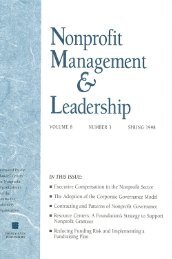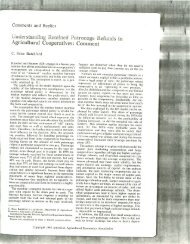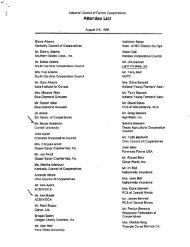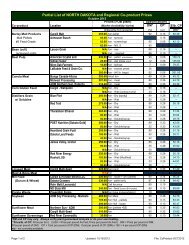Sunflower Production Field Guide - Your "Home Page"
Sunflower Production Field Guide - Your "Home Page"
Sunflower Production Field Guide - Your "Home Page"
Create successful ePaper yourself
Turn your PDF publications into a flip-book with our unique Google optimized e-Paper software.
28<br />
Quick Reference <strong>Guide</strong> to Major Sunfl ower Insects<br />
The information presented on this page is designed to be a quick reference for growers, crop consultants, fi eld scouts and<br />
others. Since this information is very brief, the user should refer to the following pages for more detailed data on life cycles,<br />
damage, descriptions, etc.<br />
Insects Description Occurrence, Injury and Economic Threshold (ET)<br />
Cutworms Dirty gray to gray brown. ET – 1 per square foot or 25 percent to 30 percent stand<br />
(several species) Grublike larva, 0.25 to 1.5 inches in length. reduction. Appear in early spring when plants are in the<br />
seedling stage, chewing them at or slightly above ground.<br />
Palestriped Adult: 1/8 inch long and shiny black, with two white ET – 20 percent of the seedling stand is injured and at risk<br />
Flea Beetle stripes on the back. The hind legs are enlarged and to loss due to palestriped fl ea beetle feeding. Scout for<br />
modifi ed for jumping. fl ea beetles by visually estimating population on seedlings<br />
or using yellow sticky cards placed close to the ground.<br />
Sunfl ower Beetle Adult: reddish-brown head, cream back with three ET – 1 to 2/seedling (adults), or 10 to 15/seedling<br />
dark stripes on each wing cover. Body 0.25 to 0.5 (larvae). Adults appear in early June, larvae shortly<br />
inch long. Larva: yellowish green, humpbacked in thereafter. Both adults and larvae chew large holes<br />
appearance, 0.35 inch in length. in leaves.<br />
Sunfl ower Adult: wingspread 0.63 to 0.75 inch, gray brown ET – none. First generation adults appear in late May to<br />
Bud Moth with two dark transverse bands on forewings. mid-June. Second generation adults appear in midsummer.<br />
Larva: Cream-colored body (0.33 to 0.4 inch) with Larvae from fi rst generation damage terminals and stalks,<br />
a brown head. whereas second generation larvae feed in receptacle area.<br />
Longhorned Adult: pale gray and 5/8 inch (6 to 11 mm) in No scouting method or ET has been developed. Adults are<br />
Beetle (Dectes) length, with long gray and black banded antennae. present from late June through August. Larvae tunnel and<br />
Larvae: yellowish with fl eshy protuberances on the feed in the petioles and stem pith and girdle the base of<br />
fi rst seven abdominal segments (1/3 to 1/2 inch) plants. Stalks often break at the point of larval girdling.<br />
Sunfl ower Stem Adult: small (0.19 inch long) weevil with a ET – 1 adult/3 plants in late June to early July. Adults<br />
Weevil gray-brown background and white dots on the back. appear in mid to late June, with larvae in stalks from<br />
early July to late summer.<br />
Thistle Caterpillar Adult: wingspread of 2 inches, upper wing surface brown ET – 25 percent defoliation, provided that most of the<br />
(Painted Lady with red and orange mottling and white and black spots. larvae still are less than 1.25 inches in length. Adults<br />
Butterfl y) Larva: brown to black, spiny, with a pale yellow stripe appear in early to mid-June, with larvae appearing<br />
on each side, 1.25 to 1.5 inches in length. shortly thereafter. Larvae chew holes in leaves.<br />
Sunfl ower Midge Adult: small (0.07 inch), tan, gnatlike insect. ET – none. Adult emergence begins in early July. Larvae<br />
Larva: cream or yellowish, 0.09 inch long, tapered at feed around head margin and at the base of the seeds,<br />
front and rear. causing shrinkage and distortion of heads.<br />
Sunfl ower Seed Adults: the red sunfl ower seed weevil is about 0.12 ET – generally 8 to 14 adult red sunfl ower weevils per head<br />
Weevils inch long and rusty in color. The gray sunfl ower seed (oil) and one per head (confectionery). Adults appear in<br />
weevil is about 0.14 inch long and gray in color. late June to early July. Treat for red sunfl ower seed weevil<br />
Larvae: both species are cream-colored, legless and at R5.1 to R5.4. Larvae feed in seeds from mid to late<br />
C-shaped. summer.<br />
Sunfl ower Moth Adult: body is 0.38 inch long, with 0.75 inch ET – 1 to 2 adults/5 plants at onset of bloom. Adults are<br />
wingspread. Color is buff to gray. Larva: brown head migratory and usually appear in early to mid-July. Larvae<br />
capsule with alternate dark and light lines running<br />
longitudinally, 0.75 inch in length.<br />
tunnel in seeds from late July to late August.<br />
Banded Sunfl ower Adult: small 0.25-inch straw-colored moth with brown ET – See banded sunfl ower moth section for egg or adult<br />
Moth triangular area on forewing. Larva: in early growth sampling methods for determining ET. Sampling should be<br />
stage, off-white, changing to red and then green color conducted in the late bud stage (R-3), usually during midat<br />
maturity, 0.44 inch in length. July. Adults appear about mid-July to mid-August. Larvae<br />
present in heads from mid-July to mid-September.<br />
Lygus Bug Adult: small (0.2 inch in length), cryptically colored ET - for CONFECTION SUNFLOWERS ONLY –<br />
insects with a distinctive yellow triangle or “V” on 1 Lygus bug per 9 heads. Two insecticide sprays are<br />
the wings and vary in color from pale green to dark recommended: one application at the onset of pollen shed<br />
brown. Nymph (immature stages): usually green and or 10 percent bloom, followed by a second treatment<br />
similar in appearance to the adults, but lack wings. 7 days later.<br />
Sunfl ower Adult: metallic, black, 0.25-inch long body with a long ET – none. Adults appear in mid to late July and create<br />
Headclipping “snout.” Larvae: 0.25 inch in length. feeding punctures around stalk just below the heads.<br />
Weevil Heads drop off.<br />
NOTE: The insects discussed above are listed in the order that they likely are to occur throughout the growing season; however, the various insects<br />
may or may not appear, depending upon overwintering survival and environmental conditions as the season progresses. The table is intended<br />
simply as a guide to when fi elds should be checked for possible presence of the various insects known to infest sunfl owers.







